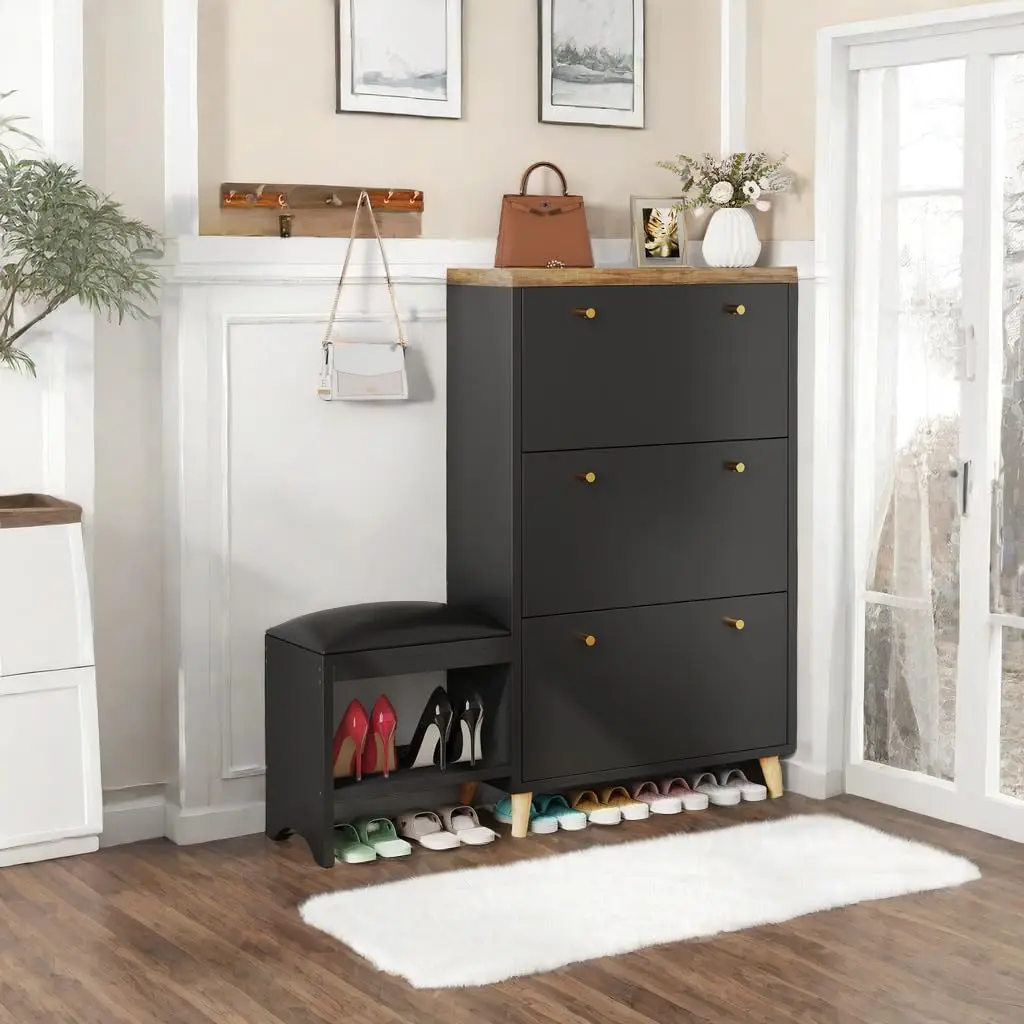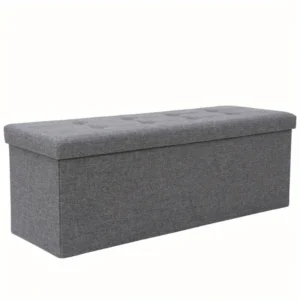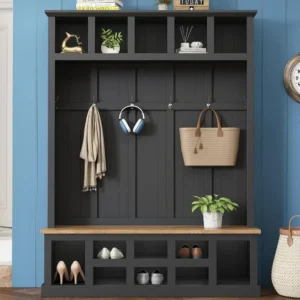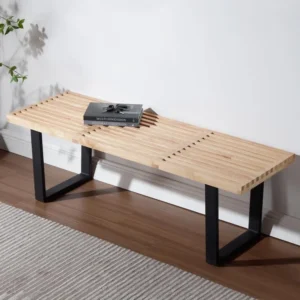Why Entryway Benches Are Essential for Small Spaces
Walking into a cluttered entryway can instantly create stress and chaos in your home. Small entryways present unique challenges – limited floor space, nowhere to sit when removing shoes, and a tendency to collect random items that have no designated storage spot. These problems compound in modern homes and apartments, where entryways have shrunk to an average of just 25-40 square feet in many urban dwellings.
Space-saving entryway benches offer an elegant solution to these common problems by:
- Providing a dedicated place to sit when putting on or taking off shoes
- Creating storage for seasonal items like hats, gloves, and umbrellas
- Establishing organization systems that prevent floor clutter
- Defining your entryway space, even in open floor plans
- Making a positive first impression for guests
The magic of these specialized pieces lies in their dual functionality. Unlike standard benches or storage cabinets, benches designed specifically for small spaces combine seating and storage in a single footprint. This 2-in-1 approach effectively doubles the functional value of each square inch they occupy.
Studies consistently show that organized entryways contribute significantly to reduced household stress levels. When items have designated places and daily transitions run smoothly, the entire home feels more peaceful. Think of your entryway as setting the tone for your entire living space – when organization starts at the door, it tends to flow throughout the home.
The transformation from cluttered chaos to organized calm doesn’t require a massive renovation or expansive space. Often, it simply requires the right piece of furniture that maximizes functionality while organizing your small entryway efficiently.
Key Benefits of Space-Saving Entryway Benches
1. Functional Seating Without the Footprint
Space-saving benches provide a dedicated spot for putting on and removing shoes without requiring the floor space of traditional seating options. Many compact designs extend only 12-15 inches from the wall while still offering comfortable seating for daily use.
2. Hidden Storage Eliminates Clutter
Perhaps the most valuable aspect of these specialized benches is their ability to hide everyday items that would otherwise create visual noise. From shoes and bags to seasonal accessories like scarves and umbrellas, the interior storage compartments keep essentials accessible but out of sight.
3. Vertical Space Utilization
In small spaces, thinking vertically is essential. Many space-saving entryway solutions incorporate vertical elements like hooks or shelves above the bench, maximizing organization potential without increasing the floor footprint.
4. Creates a Designated “Drop Zone”
Having a specific place for everyday items means keys, mail, bags, and shoes no longer end up scattered throughout your home. This designated “drop zone” creates effortless organization habits that maintain order long-term.
5. First Impression Enhancement
Your entryway sets the tone for your entire home. A thoughtfully organized space with an attractive bench creates a welcoming atmosphere for guests and a sense of calm for residents returning home.
6. Space Definition in Open Floor Plans
In homes with open layouts, a strategic bench placement can visually define your entryway as a distinct space without constructing walls or barriers. This helps establish natural traffic patterns and functional zones.
7. Improves Traffic Flow
Narrow, wall-hugging designs ensure pathways remain clear while still providing essential functions. Entryway benches with storage options keep items contained rather than sprawling across walkways, making even the smallest entryways navigable.
The versatility of these pieces means they can adapt to changing needs throughout the year. During winter, they accommodate bulkier items like boots and coats, while in summer, they store lightweight essentials like sunglasses and flip-flops—all while maintaining their core seating function.
Space-Saving Features to Look For
When shopping for a space-saving entryway bench, specific features make all the difference between a piece that truly maximizes your space and one that merely takes up room. Here are the key space-optimizing elements to prioritize:
Compact Dimensions
The defining characteristic of truly space-saving benches is their thoughtful proportions:
- Width: Space-efficient benches typically range from 24-48 inches wide, with 36 inches being an ideal balance between compact size and functionality for most small entryways.
- Depth: Look for models between 11-15 inches deep, which provide adequate seating while protruding minimally into walkways.
- Height: Standard seat heights of 17-19 inches offer comfortable seating while maintaining a low profile that won’t overwhelm small spaces.
Narrow entryway benches specifically designed for slim spaces often feature proportions optimized for hallways as narrow as 3 feet wide.
Slim Profiles
Benches with tapered legs, floating designs, or visually lightweight construction create an airier appearance that makes your space feel larger. These designs maintain functionality while creating the illusion of more space through:
- Raised legs that show floor beneath
- Thinner seat platforms without bulky frames
- Visual “breathing room” around and under the piece
Corner-Fitting Designs
One of the most innovative space-saving approaches utilizes corners—often the most underutilized areas in small entryways. Corner entryway benches feature:
- L-shaped configurations that tuck neatly into corners
- Angled backs that follow wall contours
- Triangular or wedge-shaped designs that maximize otherwise wasted space
Wall-Mounted Options
For extremely limited floor space, wall-mounted benches offer revolutionary space efficiency by:
- Eliminating floor contact entirely
- Creating usable storage space underneath
- Providing visual lightness that expands the perceived space
- Allowing for easy floor cleaning beneath
Nesting and Modular Capabilities
Some innovative designs offer:
- Nesting ottomans that tuck under the main bench when not needed
- Modular components that can be rearranged based on changing needs
- Puzzle-like pieces that combine for seating or separate for additional functions
Foldable Designs
For the ultimate in space efficiency, look for:
- Benches that fold flat against walls when not in use
- Flip-down seating that appears only when needed
- Convertible designs that transform between functions based on immediate needs
When evaluating these features, consider your specific entryway constraints and daily habits. The most space-efficient bench combines several of these characteristics while still meeting your practical needs for seating and storage.
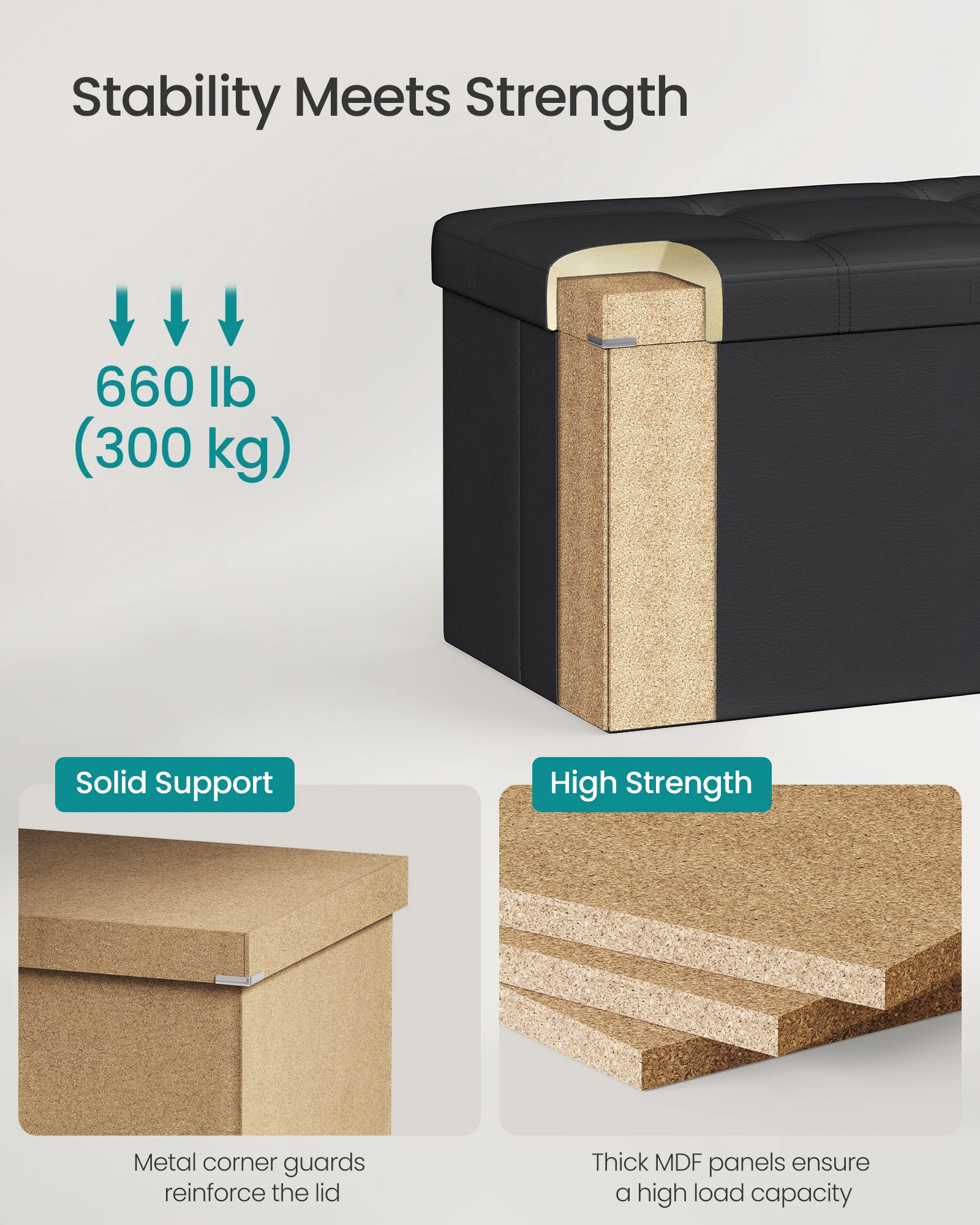
Storage Solutions: Getting More from Your Bench
The storage configuration of your space-saving bench dramatically impacts both its functionality and how effectively it reduces clutter. Each storage type offers specific advantages for different needs and spaces.
Lift-Top Storage Compartments
The classic storage bench design features a hinged seat that lifts to reveal a hidden compartment:
- Advantages: Provides the largest continuous storage volume; keeps contents completely concealed; maintains clean visual lines
- Best for: Storing larger items or seasonal accessories; hiding visual clutter; maximizing storage volume
- Storage efficiency: Typically offers 2-3 cubic feet of storage in a compact bench
Pull-Out Drawer Systems
Drawer-based storage provides organized accessibility:
- Advantages: Allows access without moving from seated position; prevents items from getting lost in a large compartment; enables categorized organization
- Best for: Frequently accessed items; smaller accessories; creating separated storage zones
- Storage efficiency: Multiple drawers create natural organization systems without dividers or additional containers
Open Shelving Configurations
Shelves beneath the seat provide quick visual access and airflow:
- Advantages: Promotes regular use of items; provides decorative display opportunities; allows air circulation for damp items like shoes
- Best for: Everyday essentials; decorative baskets or bins; items needing air circulation
- Storage efficiency: Typically accommodates 4-8 pairs of shoes or 2-3 storage baskets in a standard-sized bench
Cubby Systems
Divided compartments create natural organization:
- Advantages: Prevents items from shifting; creates dedicated spaces for different family members; accommodates varied item sizes
- Best for: Specialized shoe storage where each pair has a dedicated space; family entryways where everyone needs their own section
- Storage efficiency: Cubbies prevent wasted vertical space by creating multiple small compartments instead of one large one
Combination Storage Designs
The most versatile options combine multiple storage types:
- Advantages: Accommodates diverse storage needs; provides both hidden and display storage; maximizes storage potential
- Best for: Multi-person households with varied storage requirements; entryways that serve multiple functions
- Storage efficiency: Combining systems like a lift-top with lower shelves can increase storage capacity by 40-60% compared to single-system designs
When selecting your storage configuration, consider both what you’ll store and how frequently you’ll access those items. The most efficient option is one that maximizes small spaces with smart bench design while accommodating your specific organizational needs.
For maximum efficiency, look for designs with thoughtful internal features like adjustable shelves, built-in dividers, or modular components that can adapt as your storage needs change throughout different seasons.
Multi-Functional Marvels: Beyond Basic Seating and Storage
When space is truly at a premium, selecting pieces that serve multiple purposes becomes essential. Today’s innovative entryway solutions go well beyond the basic bench concept to deliver remarkable functionality in minimal square footage.
Integrated Coat Rack and Bench Combinations
These comprehensive units, often called hall trees, combine multiple entryway necessities in one footprint:
- Hanging space for coats, bags, and accessories
- Seating for putting on/removing shoes
- Storage for seasonal items and everyday essentials
- Mirror for last-minute appearance checks
Hall trees and coat rack benches create complete entryway systems without requiring separate pieces, saving up to 70% of the floor space that individual furniture pieces would require.
Mirror-Bench Pairings
Strategic mirror integration serves multiple purposes:
- Creates the illusion of more space through reflection
- Provides functionality for last-minute appearance checks
- Bounces light to brighten small entryways
- Eliminates the need for a separate mirror that would consume wall space
Charging Station Integrations
Modern entryway benches increasingly include tech-friendly features:
- Built-in USB ports and outlets for charging devices
- Dedicated shelves sized for tablets and phones
- Cable management systems to prevent cord clutter
- Some even include wireless charging pads integrated into the surface
Weather-Resistant Features
For entries that connect directly outdoors:
- Water-resistant finishes that prevent damage from damp shoes
- Drip trays beneath shoe storage areas
- Sealed compartments that protect contents from moisture
- Materials that withstand temperature fluctuations near exterior doors
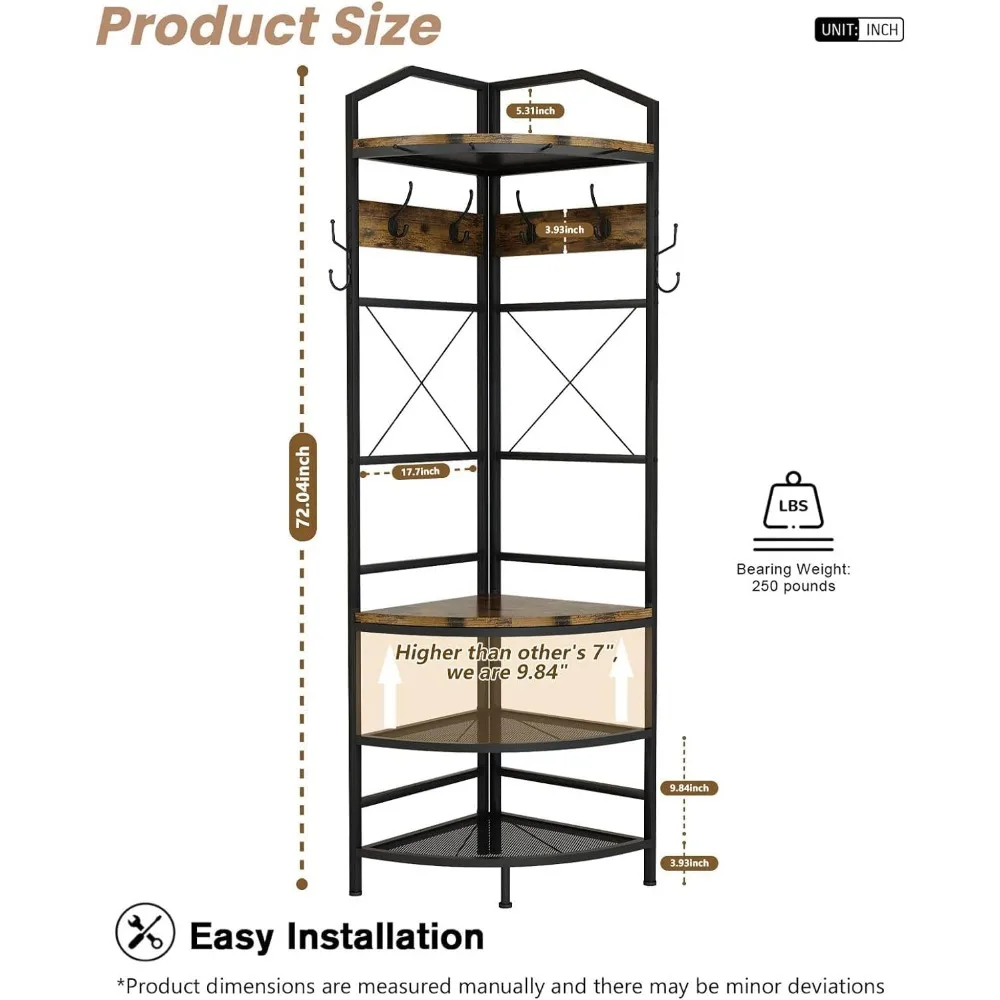
Bench-Table Convertibles
Truly innovative designs transform between functions:
- Benches that expand into console tables when needed
- Flip-top designs that create temporary work surfaces
- Nesting tables that provide occasional surface area but store compactly
Pet-Friendly Features
For animal lovers with limited space:
- Integrated leash hooks and collar storage
- Pull-out feeding station drawers
- Built-in pet bed nooks beneath seating
- Washable cushions designed for homes with pets
By combining multiple functions in one piece, these space-saving entryway seating solutions eliminate the need for several different furniture items. This approach not only conserves valuable floor space but also creates a cohesive entryway design that feels intentional rather than crowded.
When evaluating multi-functional options, prioritize the functions you’ll use daily while considering occasional needs that might otherwise require additional furniture purchases.
Choosing the Right Materials for Long-Lasting Quality
The materials used in your entryway bench significantly impact both its durability in this high-traffic area and how it visually affects your space. Here’s how different materials perform in space-constrained entryways:
Solid Wood
The classic choice for quality entryway furniture offers timeless appeal and durability:
- Space Impact: Medium to heavy visual weight; creates substantial presence
- Durability: Excellent longevity with proper care; can last decades
- Maintenance: Requires occasional polishing or oiling; may need refinishing after many years
- Best For: Investment pieces; traditional and transitional homes; creating warmth in modern spaces
Wood entryway benches range from light maple and oak that brighten small spaces to deeper walnut and mahogany that create dramatic focal points.
Metal Frames
Sleek metal structures provide strength without visual bulk:
- Space Impact: Creates visual lightness; allows light to pass through design
- Durability: Excellent for structural integrity; resistant to warping
- Maintenance: Minimal; occasional dusting and checking for loose connections
- Best For: Modern and industrial aesthetics; creating airy, open feeling in tight spaces
Engineered Wood
Budget-friendly and consistent in appearance:
- Space Impact: Can be designed in slim, space-efficient profiles
- Durability: Moderate; typically 5-10 years with proper care
- Maintenance: Keep dry; repair chips or peeling promptly
- Best For: Rental properties; frequently updated decor; budget-conscious solutions
Upholstered Elements
Adds comfort and softness to entryway seating:
- Space Impact: Adds visual softness; can make spaces feel more inviting
- Durability: Varies widely by fabric choice; performance fabrics offer best longevity
- Maintenance: Regular vacuuming; prompt stain treatment; occasional deep cleaning
- Best For: Creating comfortable seating; adding color and texture; softening modern designs
Material Combinations
Many space-efficient designs combine materials for optimal performance:
- Metal frames with wood seats balance lightness and warmth
- Wood structures with upholstered tops merge durability with comfort
- Glass elements with solid bases create visual space while providing stability
For small entryways, consider how the material affects both physical and perceived space. Lighter woods, transparent elements, and slim metal profiles tend to feel less imposing in tight quarters. However, durability should never be sacrificed for aesthetics in this hardworking area of your home.
When selecting materials, also consider their environmental impact—both sustainably harvested woods and recycled metals offer eco-friendly options that don’t compromise on quality or longevity.
Finding Your Style: Matching Your Space-Saving Bench to Your Decor
Your entryway bench, though functional, also makes a powerful style statement as the first piece of furniture guests encounter in your home. Even in small spaces, style doesn’t have to be sacrificed for functionality.
Modern and Minimalist
Clean lines and uncluttered designs create breathing room in tight spaces:
- Characteristic features: Hidden storage with no visible hardware; straight lines; monochromatic color schemes
- Space advantage: Visual simplicity creates calm, uncluttered appearance
- Material focus: Smooth surfaces in wood or metal; minimal ornamentation
- Color strategy: Limited palette with occasional bold accent
Modern entryway benches excel in small spaces by avoiding visual clutter while still delivering full functionality.
Farmhouse and Rustic
Warm and welcoming designs that blend old-world charm with practical storage:
- Characteristic features: Distressed finishes; visible wood grain; metal accents; bin storage
- Space advantage: Familiar, comfortable aesthetic makes spaces feel established
- Material focus: Reclaimed or distressed woods; black metal hardware
- Color strategy: Warm neutrals with textural variation
Traditional
Timeless designs with refined detailing create elegant entryways:
- Characteristic features: Turned legs; tufted upholstery; symmetrical designs
- Space advantage: Classic proportions often designed for smaller historical homes
- Material focus: Rich woods with careful detailing; quality upholstery
- Color strategy: Heritage colors and patterns; coordinated textiles
Industrial
Raw materials and functional forms create urban sophistication:
- Characteristic features: Exposed metal frameworks; utilitarian hardware; multi-functional design
- Space advantage: Typically lightweight visual presence despite sturdy construction
- Material focus: Black metal, reclaimed woods, concrete elements
- Color strategy: Neutral base with natural material highlights
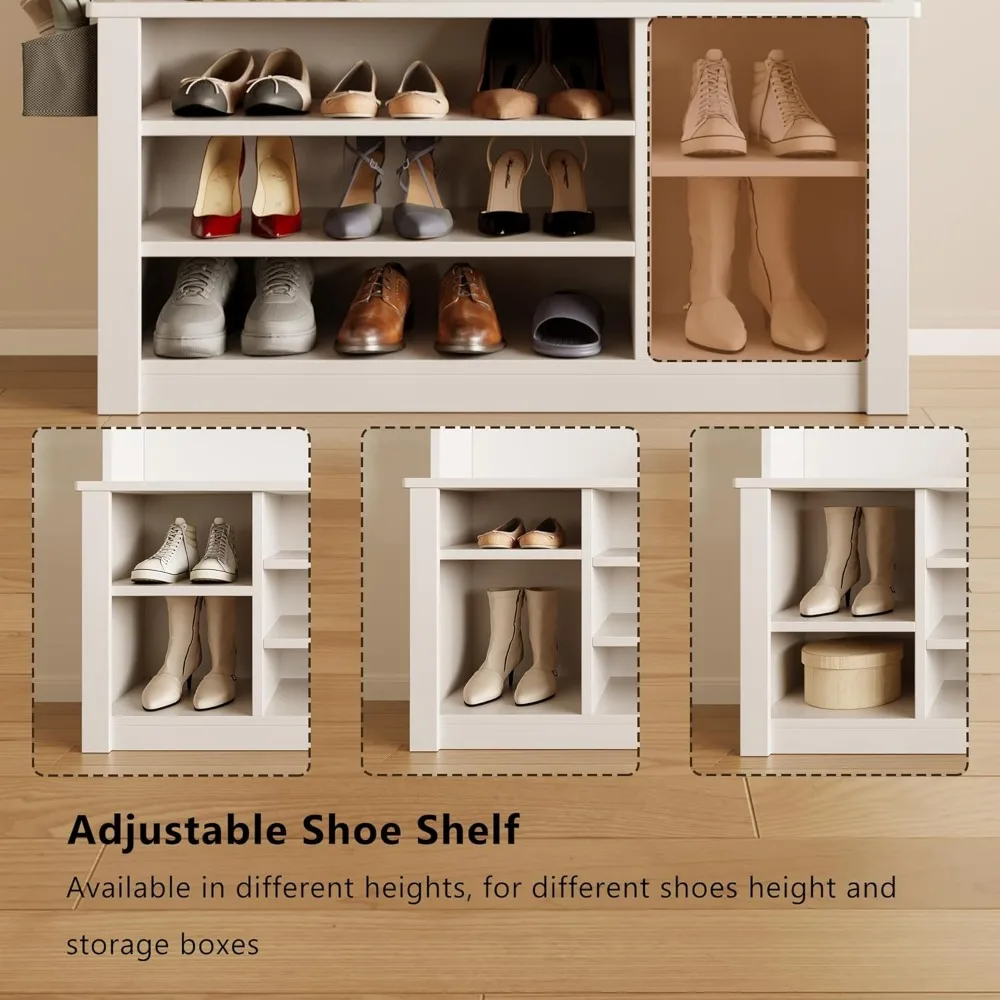
Mid-Century Modern
Retro-inspired pieces with clean lines and organic curves:
- Characteristic features: Tapered legs; organic curves combined with geometric forms
- Space advantage: Raised profiles show floor beneath, creating visual space
- Material focus: Warm woods like teak and walnut; occasionally colorful upholstery
- Color strategy: Warm wood tones with strategic pops of color
Contemporary Fusion
Blended styles that cherry-pick elements from various design traditions:
- Characteristic features: Unexpected material combinations; updated traditional forms
- Space advantage: Can be precisely tailored to space requirements
- Material focus: Innovative combinations like acrylic with wood or metal with glass
- Color strategy: Often neutral with deliberate accent moments
When selecting a style for small spaces, remember that scale matters as much as aesthetic. Modern bench styles for small spaces typically feature proportions specifically designed not to overwhelm tight areas while maintaining style integrity.
Regardless of which style you choose, consistency with your overall home design creates visual flow that makes spaces feel more expansive and intentional. Consider your entryway bench as both a functional piece and the introduction to your home’s design story.
Measuring for Success: Ensuring Perfect Fit
The difference between a bench that transforms your entryway and one that creates an obstacle often comes down to precise measurement. Follow this step-by-step guide to ensure your space-saving bench fits perfectly:
Step 1: Measure Available Width
Determine the maximum width your space can accommodate:
– Measure the wall where the bench will sit
– Subtract 6-12 inches (15-30 cm) from the total width to allow visual breathing room
– For very small spaces, look for benches between 24-36 inches (61-91 cm) wide
– For medium entryways, benches up to 48 inches (122 cm) may work well
Step 2: Determine Appropriate Depth
The depth of your bench impacts both comfort and walkway clearance:
– Measure from the wall to the minimum clear walkway you need to maintain
– Standard bench depths range from 12-18 inches (30-46 cm)
– For narrow hallways, look for slim designs under 14 inches (35 cm) deep
– Remember that some storage benches require additional clearance for opening lids or drawers
Step 3: Assess Height Considerations
Perfect entryway bench height balances comfortable seating with proportional appearance:
– Standard bench seat heights range from 17-19 inches (43-48 cm)
– Measure any existing furniture for comparison
– Consider who will use the bench most frequently
– For benches with integrated coat racks or shelving, ensure overhead clearance
Step 4: Account for Door Clearance
Doors require unobstructed movement:
– Open all doors fully to verify clearance needs
– Allow at least 2 inches (5 cm) between any door swing and your bench
– Consider both entry doors and closet doors in your measurements
– Remember that seasonal items like winter boots may extend beyond the bench’s footprint
Step 5: Evaluate Traffic Flow
Observe how people naturally move through your space:
– The main walkway should remain at least 30-36 inches (76-91 cm) wide
– Map the path from entry to main living areas to avoid creating obstacles
– Consider multiple users navigating the space simultaneously
Step 6: Consider Scale and Proportion
Beyond raw dimensions, visual weight affects how your bench fits the space:
– In small areas, choose benches with visible legs that show floor underneath
– Consider the height of your ceilings when selecting tall hall trees or coat rack combinations
– Select visual weight appropriate to your space—heavier, darker pieces in larger areas; lighter, more delicate pieces in smaller spaces
Taking precise measurements before shopping prevents the disappointment of returns and ensures your bench enhances rather than crowds your entryway. Keep these measurements handy while shopping, particularly for online purchases where you’ll rely entirely on listed dimensions.
Strategic Placement: Maximizing Your Small Entryway
Where you position your bench can be just as important as which bench you choose. Strategic placement maximizes functionality while enhancing the perception of space.
Wall-Adjacent Positioning
The most common and often most practical placement hugs one wall:
- Best for: Rectangular entryways; narrow hallways; creating clear traffic lanes
- Space-saving advantage: Minimizes footprint intrusion into walkways
- Design consideration: Leaves wall space above for hooks, mirrors, or artwork
- Practical tip: Position 4-6 inches from adjacent walls for visual breathing room
Corner Configurations
Corner bench solutions transform often wasted areas into functional zones:
- Best for: Square entryways; open floor plans needing spatial definition
- Space-saving advantage: Utilizes traditionally underused corner spaces
- Design consideration: Creates natural traffic flow around the corner
- Practical tip: L-shaped or angled designs specifically made for corners maximize space utilization
Under-Window Placement
Windows often create challenging wall spaces that benches can perfectly fill:
- Best for: Entryways with low windows; spaces needing natural light
- Space-saving advantage: Uses wall space that might otherwise remain empty
- Design consideration: Choose height-appropriate bench that doesn’t block light
- Practical tip: Ensure window can still open properly if needed
Float Placement
Placing a bench away from walls works in larger entryways to define spaces:
- Best for: Open-concept entries; larger foyers needing division
- Space-saving advantage: Creates zones without walls; defines traffic patterns
- Design consideration: Choose bench with finished back if visible from all sides
- Practical tip: Anchor visually with a rug beneath to define the space
Asymmetrical Balancing
For irregular entryways, strategic placement creates visual balance:
- Best for: Spaces with architectural irregularities; unusual layouts
- Space-saving advantage: Creates intentional design from challenging spaces
- Design consideration: Use bench to counterbalance other elements like stairs or columns
- Practical tip: Position to create the most efficient path to main living areas
Sight Line Considerations
The view upon entering affects the perceived spaciousness:
- Align bench with the natural line of sight when entering
- Avoid placements that create immediate visual obstacles
- Consider what’s visible beyond the entryway when positioning
- Use mirrors strategically to extend sight lines
Remember that proper placement should prioritize both functionality and traffic flow. Even the most beautiful, space-efficient bench becomes problematic if it interrupts the natural movement patterns of your home.
Creating a Complete Entryway: Styling Around Your Bench
Transform your space-saving bench into the foundation of a cohesive, functional entryway by thoughtfully styling the surrounding elements.
Vertical Storage Integration
Maximize your entryway’s functional capacity by utilizing wall space above and around your bench:
- Install hooks at 5-6 feet height for coats and bags
- Stagger hook heights for different family members
- Consider a small floating shelf at eye level for keys and mail
- Mount slender cabinets above benches with low profiles
Mirror Placement for Space Enhancement
Mirrors do double duty by providing both function and the illusion of more space:
- Position mirrors to reflect light sources for brightness
- Place directly above benches for last-minute appearance checks
- Consider full-length options for narrow walls beside benches
- Choose frames that complement bench materials for cohesiveness
Lighting Strategies
Proper lighting makes small entryways feel more welcoming and spacious:
- Install sconces on either side of a bench to frame the space
- Consider a small table lamp on one end of the bench for warm illumination
- Add battery-operated puck lights inside storage compartments
- Ensure overhead lighting adequately brightens the entire area
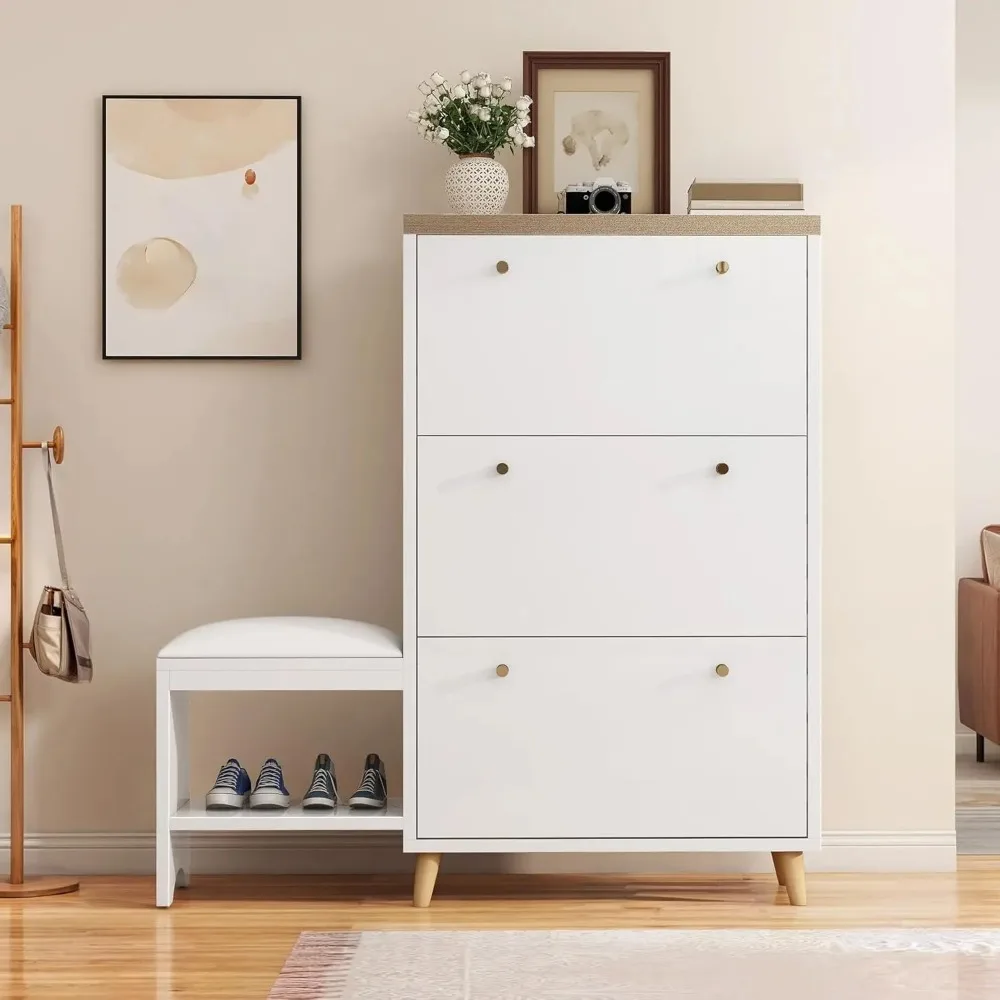
Storage Accessories
Enhance your bench’s organization capabilities with thoughtful accessories:
- Add small baskets to corral items like gloves and scarves
- Use drawer dividers in bench storage to separate items by family member
- Place a decorative tray on the bench surface for catching small items
- Consider shoe trays beneath open-shelf benches to contain dirt
Rug Selection and Placement
The right rug anchors your entryway while protecting floors:
- Choose indoor/outdoor materials for durability in this high-traffic area
- Size the rug to extend 4-6 inches beyond the bench on all sides
- Select patterns that hide inevitable dirt and debris
- Consider washable options for easy maintenance
Art and Decor
Personal touches make your entryway welcoming while reflecting your style:
- Hang artwork at eye level above benches
- Group smaller frames in visually balanced arrangements
- Choose weather-appropriate seasonal decor that doesn’t consume limited surface area
- Add a small plant for life and color where space allows
Many small benches for entryways are designed to work with coordinating wall pieces, creating comprehensive solutions for complete organization. When selecting these complementary items, maintain consistent finishes and hardware for a cohesive look.
Remember that in small spaces, editing is crucial. Each item should serve a purpose, and negative space should be preserved to prevent a cluttered appearance. Aim for the perfect balance of function and beauty, where everything has a place, but the space still feels open and inviting.
Space-Saving Success Stories: Real-World Examples
See how thoughtfully selected benches transformed these challenging entryways into functional, beautiful spaces.
The Narrow Hallway Solution
Challenge: A 42-inch wide hallway entrance with no dedicated entryway space
Solution: A slim 12-inch deep bench with vertical storage integration transformed this narrow pass-through into a functional entry zone without impeding traffic flow.
Key Features:
– Wall-mounted bench eliminating floor footprint
– Overhead hooks replacing need for coat rack
– Mirror positioned to reflect light down the hallway
– Shoe storage confined to vertical cubbies
Result: The bench created a designated drop zone while actually making the hallway feel wider by organizing items that previously cluttered the floor.
The Awkward Corner Transformation
Challenge: A small apartment entry with an awkward 90-degree corner and no defined entryway
Solution: A corner-specific design utilized the traditionally difficult space, creating function where only wasted space existed before.
Key Features:
– L-shaped bench following wall contours
– Built-in shoe storage beneath seat
– Wall hooks positioned above both sides
– Basket storage for seasonal items
Result: The previously unused corner became the apartment’s most functional organization zone, proving that no space is too awkward for proper planning.
The Open-Concept Definition
Challenge: A modern home with no architectural entryway definition
Solution: A dual-sided storage bench created a visual boundary between the entry area and living space while providing storage accessible from both sides.
Key Features:
– Bench position perpendicular to the entry door
– Storage accessible from front and back
– Coordinating area rug defining the “entryway”
– Complementary console for additional organization
Result: Without constructing walls, the homeowners successfully created a defined entry experience while maintaining the open floor plan.
The Family-Friendly Small Space
Challenge: A modest entryway serving a family of five with minimal square footage
Solution: A comprehensive organization system centered around a compact storage bench with designated space for each family member.
Key Features:
– Color-coded hooks and storage cubbies
– Low bench height accessible to young children
– Durable, washable materials throughout
– Rotating seasonal storage solutions
Result: The space now handles the organizational needs of the entire family while teaching children about organization from an early age.
Many space-saving entry benches for small homes offer inspiration for similar challenges. These success stories demonstrate that with proper selection and placement, even the most challenging entryway constraints can be overcome with thoughtful design and furniture selection.
Maintenance Tips for Long-Lasting Performance
Keep your space-saving entryway bench looking beautiful and functioning perfectly with these material-specific maintenance strategies.
Wood Bench Maintenance
- Dust regularly with a soft, dry cloth to prevent buildup
- Clean spills immediately with a slightly damp cloth, then dry thoroughly
- Apply furniture polish or appropriate wood oil every 3-6 months
- Avoid placing hot items directly on wooden surfaces
- Use coasters under wet items to prevent water rings
- Consider furniture wax annually for added protection
Metal Element Care
- Wipe with a soft cloth dampened with water and mild soap
- Dry thoroughly after cleaning to prevent spotting or corrosion
- Apply a light coat of furniture wax to painted metal for protection
- Check and tighten any screws or connectors quarterly
- Touch up any chips in painted metal promptly to prevent spreading
Upholstery Preservation
- Vacuum fabric regularly using upholstery attachment
- Treat spills immediately with appropriate cleaners for fabric type
- Consider fabric protection sprays for high-traffic entryways
- Test any cleaning solutions on hidden areas first
- Rotate cushions if possible to distribute wear evenly
- Follow manufacturer cleaning codes for specific materials
Storage Mechanism Maintenance
- Lubricate hinges on lift-top benches annually with silicone spray
- Clean drawer tracks and apply wax for smooth operation
- Avoid overloading storage compartments beyond recommended weight
- Check and tighten hardware quarterly or when pieces feel loose
- Keep storage compartments dry to prevent odors or mildew
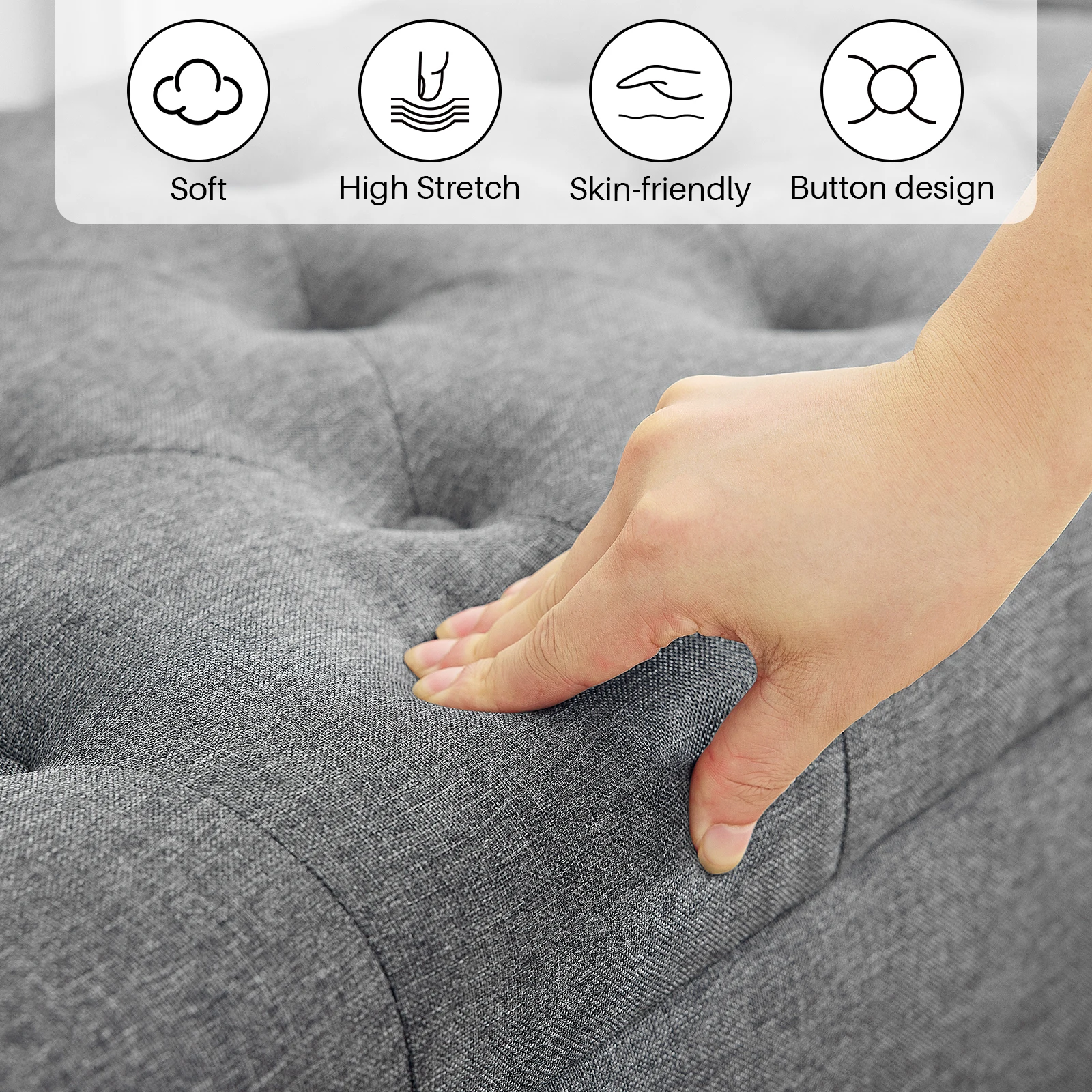
Seasonal Care Routine
Spring Cleaning:
– Deep clean all surfaces according to material guidelines
– Check and repair any winter damage from boots, salt, or moisture
– Consider refreshing any protective finishes
Fall Preparation:
– Ensure all mechanisms work smoothly before heavy winter use
– Check storage capacity for seasonal items like gloves and scarves
– Apply protective treatments before heaviest use season
By following these simple maintenance routines, your entryway bench will continue to function beautifully while maintaining its appearance for years to come. Proper care ensures that your space-saving solution remains an asset rather than becoming another problem to solve.
Making Your Choice: How to Shop and What to Consider
Selecting the perfect space-saving bench involves balancing numerous factors. Here’s how to make the right choice for your specific needs:
Budget Considerations
Space-saving entryway benches typically fall into several price categories:
– Budget-friendly ($100-250): Typically engineered wood construction with basic storage
– Mid-range ($250-500): Solid wood construction or premium engineered materials with better hardware
– Investment pieces ($500+): Solid hardwoods, custom dimensions, premium mechanisms, extended warranties
When evaluating price points, consider:
– Cost per function (more multi-functional pieces often justify higher prices)
– Expected lifespan (quality pieces amortized over many years)
– Material quality and long-term durability
Feature Assessment Strategy
Determine which features provide the most value for your specific situation:
– Prioritize storage types that match your specific organizational needs
– Consider family size and daily traffic when evaluating capacity
– Weigh the importance of aesthetics versus pure functionality
– Identify “must-have” versus “nice-to-have” features
The complete guide to choosing a compact bench suggests focusing on your top three non-negotiable requirements before considering additional features.
Where to Shop
Different shopping venues offer distinct advantages:
– Specialty furniture stores: Offer expert guidance and quality, but higher prices
– Mass-market retailers: Provide budget options with convenient delivery
– Online marketplaces: Offer vast selection but require careful dimension verification
– Custom builders: Create perfect-fit solutions for challenging spaces at premium prices
Assembly Considerations
Factor in the full ownership experience:
– Complex assembly may add hidden costs if professional help is needed
– Check whether tools are included or must be purchased separately
– Read reviews specifically mentioning assembly experience
– Consider whether disassembly might be needed for future moves
Quality Indicators
Learn to identify signs of quality construction:
– Dovetail or mortise-and-tenon joints in wood pieces
– Smooth-operating hinges and mechanisms
– Even finish application without bubbles or streaks
– Aligned hardware and tight seams
– Weight appropriate to materials (too light often indicates lower quality)
Affordable entryway bench solutions can still offer good quality when you know what construction elements to prioritize. Focus on sturdy construction in the frame and high-quality hardware even if other elements are more basic.
Coat Rack Shoe Bench, Corner Entryway Bench, Corner Hall Tree, Shoe Bench for Entryway
$313.58 Select options This product has multiple variants. The options may be chosen on the product pageEntryway Bench with Back, Modern Entryway Bench, Shoe Bench for Entryway
Price range: $463.13 through $474.44 Select options This product has multiple variants. The options may be chosen on the product pageEntryway Bench with Shelf Storage, Shoe Bench for Entryway, Shoe Storage Bench
$194.08 Select options This product has multiple variants. The options may be chosen on the product pageCorner Entryway Bench, Entryway Bench with Cushion, Modern Entryway Bench, Shoe Bench for Entryway
$476.34 Select options This product has multiple variants. The options may be chosen on the product pageBench with Hooks and Storage, Entryway Hall Tree, Mudroom Bench with Cubbies, Mudroom Bench with Shoe Storage
$818.38 Select options This product has multiple variants. The options may be chosen on the product pageModern Entryway Bench, Wood Entryway Bench, Wood Mudroom Bench
$497.69 Select options This product has multiple variants. The options may be chosen on the product page
Remember that the perfect bench for your space balances price, features, quality, and style. Prioritize the elements most important to your daily life while considering how this piece will serve you over many years.
Bringing It All Together: Creating Your Perfect Entryway
Transforming your small entryway into an organized, welcoming space ultimately comes down to thoughtful planning and selection. The perfect space-saving bench serves as the foundation of this transformation, combining essential functions while respecting your spatial constraints.
When selecting your bench, remember that successful small-space solutions balance several key elements:
- Proportional design that respects the scale of your space
- Multi-functionality that eliminates the need for multiple furniture pieces
- Quality construction that withstands the demands of daily use
- Storage configurations that address your specific organizational needs
- Style elements that complement your overall home design
Rather than viewing your small entryway as a limitation, see it as an opportunity to create a highly efficient, beautifully designed space that sets the tone for your entire home. The constraints of compact spaces often lead to the most innovative and satisfying solutions.
The most successful entryways evolve with your needs while maintaining their core functionality. Look for adaptable pieces that can transition through seasonal changes and accommodate your household’s evolving requirements. Remember that even small changes—like switching out baskets, updating hooks, or rearranging storage—can refresh your entryway as needs change.
When bringing all elements together, maintain a critical eye toward clutter. In small spaces, the discipline to contain and organize items makes the difference between a cramped, chaotic entrance and a serene, welcoming one. Establish simple systems that make daily organization automatic rather than effortful.
With the right space-saving bench as your foundation, complementary elements thoughtfully selected, and maintenance routines established, your entryway will transform from a challenging space into one of your home’s most functional and welcoming areas—proof that beautiful, organized living doesn’t require endless square footage, just creative thinking and purposeful design.
FAQs: Common Questions About Space-Saving Entryway Benches
What’s the minimum width for an effective entryway bench?
For a functional entryway bench that provides adequate seating, look for at least 24 inches (61 cm) in width. This provides enough space for one adult to sit comfortably. However, ultra-narrow spaces can accommodate bench widths as small as 18-20 inches (46-51 cm) if the primary purpose is organization rather than seating. Remember that width affects stability—very narrow benches should be secured to the wall for safety.
Can entryway benches work in apartments with no defined entryway?
Absolutely! In open-concept apartments, an appropriately sized bench can actually create a defined entryway where none exists architecturally. Position the bench perpendicular to the entry door with a small area rug beneath to visually define the “entryway zone.” Choose a bench with a finished back if it will be visible from the living area, or place it against a wall with hooks above to maximize functionality without consuming too much open floor space.
How much weight can space-saving benches typically hold?
Most quality entryway benches are designed to support 250-400 pounds (113-181 kg) of seated weight. However, storage compartments typically have lower weight ratings, usually between 25-50 pounds (11-23 kg) for lift-tops and 10-25 pounds (4.5-11 kg) per drawer or cubby. Always check the manufacturer’s specifications for both seating and storage weight limits, especially if multiple people will use the bench simultaneously.
Are there weatherproof options for exterior entry spaces?
Yes, many manufacturers offer entryway benches designed specifically for covered porches, mudrooms, and transitional spaces exposed to temperature fluctuations and occasional moisture. Look for benches made from:
– Treated or naturally weather-resistant woods like teak, cedar, or acacia
– Powder-coated metal frames that resist rust
– Marine-grade hardware that won’t corrode
– UV-resistant upholstery if cushioned seating is desired
These options provide entryway organization while withstanding moderate exposure to elements.
What’s the difference between a storage bench and a hall tree?
A storage bench focuses primarily on seating with secondary storage functionality, typically featuring a bench seat with storage underneath. A hall tree is a more comprehensive entryway solution that includes:
– Bench seating
– Coat hooks or hanging rod
– Often a mirror
– Sometimes additional shelving above
– Usually some form of storage beneath the seat
Hall trees provide complete entryway organization in one piece but require more vertical space and typically cost more than simple storage benches.
Can space-saving benches be comfortable for daily use?
Many space-saving benches prioritize function and compact dimensions over padded comfort. However, numerous options provide good comfort while maintaining slim profiles:
– Look for ergonomic seat heights between 17-19 inches (43-48 cm)
– Consider benches with slight contours that follow body shape
– Explore options with padded cushions made from high-density foam
– Select upholstered benches with adequate cushioning for frequent use
For occasional use, even basic wooden benches provide adequate comfort, while daily-use benches might warrant investing in cushioned options.
How do I know if a bench will fit through my doorway during delivery?
Always compare the bench’s largest dimension (typically width) to your doorway width, allowing at least 1-2 inches (2.5-5 cm) clearance. For benches with removable legs, subtract the leg height from overall dimensions. Many space-saving benches ship partially or completely disassembled specifically to address delivery concerns. Check product descriptions for “assembly required” or “knockdown construction” indicators, which usually mean the piece can navigate tight doorways or narrow stairwells during delivery.
Which storage type is best for families with children?
For households with children, prioritize:
– Open cubbies at child height for easy access
– Soft-close hinges on lift-top storage to prevent pinched fingers
– Sturdy construction that withstands climbing and rough use
– Washable materials or removable/washable covers
– Rounded corners for safety
– Individual storage sections labeled or color-coded for each child
Bench storage systems that allow children to independently organize their own items tend to be most successful in family entryways.

